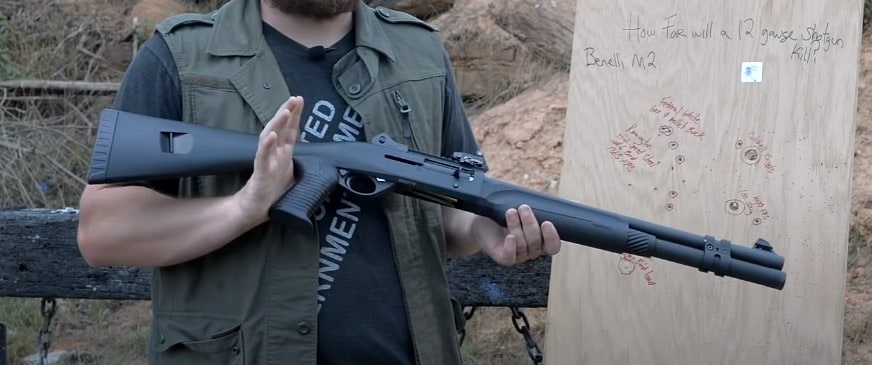How To Determine A Shotgun’s Effective Range?

Shotgun effective range is the distance at which a shotgun can effectively kill an enemy with one shot. It is a general term that goes by different names depending on the type of shotgun being used.
Finding out your shotgun’s effective range can be important for various reasons. No matter if the shotgun is being used for hunting or defense, it helps to know how far you can be from the target to have the result of putting the target down.
This is especially important in protection, but you don’t want that deer walking away, either.
In any case, you have to take into account the ammunition when buying a shotgun, regardless of its purpose. Shotguns are available with a variety of ammo types, and it’s important to understand their differences.
A few factors go into a shotgun’s effective range, and if you continue reading, you will find out what those are so you can figure out the effective range for your gun.
Things That Effect Range:
Three main things affect the effective range of your shotgun.
- The first is the gun itself, and the ammunition used
- the second is the mental state of the target
- And the third is your skill with the gun
You can change two of the three, so you can increase your effective range if needed or create a setup that has a farther effective range. However, you cannot change the mental state of the target.
You may be wondering how the target’s mental state affects its effectiveness. You probably thought only the gun and ammo mattered, but that isn’t the case. If the target is angry or has adrenaline high, then you will have to do more damage to it to bring it down.
This means having more of your ammo hit it. The situation is even worse if it is a home invader who may be on drugs.
A Shotgun’s Effective Range
The shotgun is a relatively close-range weapon compared to rifles. Its versatility is also attributed to its ability to fire various ammunition types compared to a rifle.
Several factors influence the effective range of your shotgun, including gauge, barrel length, ammunition type, choke, and more.
A shotgun’s effective range is important to consider when choosing ammunition or assigning it a specific role – such as a sporting gun, defensive weapon, or survival tool. Ammunition type is, however, a crucial consideration. As a general rule, shotguns fire three kinds of ammunition:
Slugs
Slugs are usually solid projectiles about the diameter of the bore or small projectiles in a plastic sabot. There is no doubt that slugs are designed to penetrate deeply into wounds and cause mass trauma. However, when compared with buckshot, slugs have greater barrier penetration outside of a hunting context.
Buckshot
The most common type of shotgun ammunition for self-defense, law enforcement, and military service is buckshot. Pellets with a caliber of .24 or higher make up buckshot.
Birdshot
The most common type of shot to use when hunting birds and skeets is birdshot, which is commonly used for recording skeet shots. Consequently, birdshot contains many lightweight small pellets, typically smaller than .20 caliber and sometimes as small as .01″.
Chokes
By using a choke, you can extend the effective range of buckshot. By preventing buckshot from spreading as it leaves the barrel, a choke allows you to control its spread. Pellets will remain inside a target for longer if the density is higher, allowing pellets from a distance to remain inside the target for longer.
It does not affect the energy parameter, however, if you want to increase it. This is because your cartridge will need to be charged with more propellant powder instead. Because low-pressure, fast-burning powders have little effect on muzzle velocity, barrel length has little effect.
A Bit More About Slugs
It is important to distinguish slugs from other types of ammo. Shotgun slugs can be compared to heavy rifle bullets as single projectiles. Slugs are typically flat-nosed or hollow-point projectiles with a high drag coefficient, so they’re not as aerodynamic as other projectiles. While they have their downsides, they still have a longer range than shot pellets and many handgun bullets.
The effective range of your shotgun can be increased to 80 to 150 meters when you pair shotgun slugs with rifle-style sights. However, the trajectory of the rifle slug will make it increasingly difficult for you to hit targets beyond this distance.
Spread
Buckshot and birdshot are composed of multiple pellets that disperse as soon as they are fired. The spread of these particles is what is referred to as dispersion. Shooting pellets travel farther away from the target, causing the shot pattern density to dissipate, reducing the chances of hitting.
The pellets also lose kinetic energy as they are constantly slowed by air resistance or drag. It is important to note that the less energetic the pellets are when striking a target, the less disruptive and penetrating their effect will be.
Despite the FBI’s minimum penetration standard, #00 buckshot pellets continue to meet or exceed it at 50 meters. Among the lighter pellets, #1 and especially #4 will not be able to penetrate as deeply at extended ranges and will only penetrate to comparatively shallow depths.
Shotgun buckshot loads in a 12-gauge can be effective against a human adversary up to 60 meters away, depending on the choke. The #00 buckshot has an effective range of 40–50 meters in cylinder-bore shotguns. However, a reliable hit is not guaranteed beyond that range due to the wide pattern.
Furthermore, as pattern density decreases, fewer pellets are likely to reach the target, reducing their terminal effectiveness. There can also be a connection between the brand of shotgun ammunition and the wad or shot cup design.
You should limit the range of buckshot to 25 meters or less for the best results. When fired through a barrel with a cylinder bore, the pellets you fire will all stay inside a target the size of a man’s chest. Almost any defensive application would benefit from this.
What Affects How Much Ammo Hits The Target?
Well, that is where the type of shotgun and ammo comes into effect. Bird shot, for example, shoots out a lot of small pellets, and because they are small means, they spread more.
Buck shot, on the other hand, doesn’t spread as much and has larger rounds, so you need fewer to hit the target. Lastly, a slug spreads even less, but because of this, you need better aim to hit the right spot.
Having a chock on your shotgun can affect the spread, though, and that is why it is not just the ammo that affects the effective range of a shotgun. A chock forces the load into a smaller compact area before leaving the gun. This means that the ammo doesn’t have room to spread as far.
The Last Factor Is Your Skill
If you aim better or have a good sight, you might squeeze in a few more feet for your effective range. Practicing with your gun and knowing how it handles it is a good way to increase your skill.
A good rule of thumb, though, is most shots spread about one inch per foot back, so if you need a grouping that is thirty inches to hit the vital area of a person, then you should be at most thirty feet back.
This is just a basic rule, though, and practicing with your gun can help you figure out how much spread your grouping has.
Best Set Up For Your Shotgun
Finding the best setup to increase range is hard. Skill is a big part of it, and practicing is the only way to importer that. Another thing you can do, though, is choosing ammo that doesn’t spread as much.
Most people go for Buck Shot. This has a good spread pattern and has large enough rounds to do lethal damage. There are some advantages to bird shot, though, for home defense.
At close range, it has enough little pellets to do a lot of damage. However, these little pallets have a hard time making it through doors and walls, so others will not get hurt.
The Next Thing Is To Pick A Shotgun That Fits You
You need to consider its compactness of it and also consider the type of chock it has. If you are going to be hunting birds, you want to spread, but for larger things, you might want the barrel to be reduced by a chock.
The best thing is to consider the primary purpose of the shotgun when you go to buy it. For example, for home defense, you will want a different gun than for bird hunting.
There are many reliable options on the market, and you can find one that meets your needs and gives you satisfactory results at the range you want. Getting the best scope for a shotgun also helps you have the best result when shooting.
Note From The Author:
A buckshot-firing shotgun may be capable of hitting a man-size target from 50 meters away, but several pellets might not hit the intended target.
A more accurate weapon may be better suited to the environment. A bystander close to the target is more likely to be injured by stray pellets.
To achieve consistent results, you should determine how your shotgun patterns with different ammunition and adjust your weapon, choke, or ammo accordingly.
If you have an adjustable choke, try firing a variety of shotshells at varied distances using different chokes or choke settings.
Depending on weight and design, a slug cartridge will also impact at different points. The aerodynamic properties of some slugs may be superior to those of others, while others may be contained inside a sabot that contains sub-caliber projectiles.
Conclusion
Now you know that a few factors go into the range of a shotgun, and they don’t just start and end with the gun and ammo.
While the ammunition of choice and the chock and sights of the gunplay have an effect, the mental state of the target and your skill are also factors.
The effective range of a shotgun can vary from person to person and from target to target. The key thing is that you have enough ammo to hit the target at vital points.
The spread of the ammo combined with your distance determines this, and with practice, you can learn the effective range of your shotgun.

